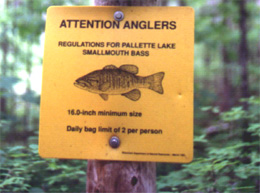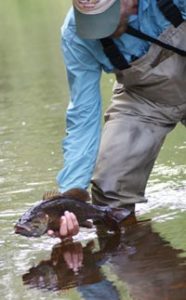While most serious smallmouth bass anglers diligently practice catch and release, unfortunately we also know that some guys still keep lots of their smallmouth bass and oppose regulations that mandate release. And one of the tactics that kill anglers use to confuse the issue and to derail catch-and-release regs is to say that it does little to improve a fishery.
 So to increase acceptance of catch and release, and to increase the amount of C&R waters, we should understand the biology behind releasing smallmouth bass and be able to clearly explain it to others.
So to increase acceptance of catch and release, and to increase the amount of C&R waters, we should understand the biology behind releasing smallmouth bass and be able to clearly explain it to others.
For smallies, the primary result of catch and release will be to increase average size of the bass. Only in limited situations (mostly in places where angler harvest is high and reproduction low) will reducing harvest also lead to a major increase in overall abundance of bass.
The biology goes like this: In many places with good reproduction, even though there are moderate levels of angler kill, the pounds of smallmouth per mile of river is already around the biological maximum (for example, 200 pounds). But the average bass size is low (say half a pound) because most fish are kept when they reach a foot or so. And at the half-pound average size it means there are 400 smallies per mile. On the other hand, if that river got C&R regs, the biomass of fish may well remain around 200 pounds per mile. And if the average size increased to 2 pounds there would only be about 100 bass per mile.
But of course, very few anglers are happy just catching 9-inchers (half-pounders) even though there are lots of them per mile. In fact, the great majority of those who deliberately target smallies would much rather fish a stream where the average is 15 inches (2 pounds) even though that water has less total fish.
Success Stories
Pallette Lake
Pallette is a 176-acre lake in Wisconsin used by the state fishery department for research. The state controls access to the lake, but for many years they allowed unrestricted angling to measure the affects on the smallmouth bass. As a result of this heavy kill, average bass size was only 9 inches. Then the researches implemented a 16-inch minimum size. Even though the fishery had been heavily exploited for decades, within several years the average smallmouth bass size climbed to 14 inches, even though angling pressure remained substantial. This is a 5-inch increase in size and is regarded as a dramatic improvement by biologists and anglers alike. This is especially impressive for a lake like Pallette, which is a very infertile slow-growing body of water.
Sylvania
Here’s another catch-and-release success story I know well. Michigan’s Sylvania Tract is a cluster of 15 small, beautiful lakes nestled in a 20,000-acre parcel of old growth forest. While Sylvania’s smallmouth are exceptionally slow-growing and angling pressure is very high, the fish are protected by “artificials only, no-kill” angling regulations. And despite the fact that Sylvania is a very popular smallmouth bass destination, average fish size is outstanding, and high numbers over 18 inches are landed every year.
Upper Mississippi
Yet a third example of highly successful catch and release is the upper Mississippi just north of Minneapolis. Just a medium-sized river this far north, the Miss is next door to 2.5 million people. Though it’s fished hard for smallies, the numbers of bass over 17 inches remains outstanding, and 20-inchers are regular catches. This exceptional fishery, next to a major urban area, is due to the 12- to 20-inch protected slot regulation the river has had the past 15 years.
These and dozens of other situations where protective regulations allowed the smallmouth bass population to flourish should be clearly pointed out to anglers, fisheries departments and state politicians alike.
The Right Way
To be successful, C&R regs must implemented the right way and on the right waters. Marginal smallmouth rivers and lakes often have such poor habitat or severe environmental problems that they likely won’t see much improvement no matter the angling regulations. And extremely heavy live bait use can also limit how much a fishery improves because of the high number of gut-hooked fish, which will die from hooking mortality.
 Widespread cheating (where a significant portion of the anglers don’t comply with the regulations) will also significantly reduce the effectiveness of them. One other danger to watch out for are wishy-washy regs. Sometimes timid state agencies propose minimal regs (like a 14-inch minimum or 12- to 16-inch slot) because they’re afraid anything stronger will be opposed. Generally, these limited protections only lead to modest improvements in fish size.
Widespread cheating (where a significant portion of the anglers don’t comply with the regulations) will also significantly reduce the effectiveness of them. One other danger to watch out for are wishy-washy regs. Sometimes timid state agencies propose minimal regs (like a 14-inch minimum or 12- to 16-inch slot) because they’re afraid anything stronger will be opposed. Generally, these limited protections only lead to modest improvements in fish size.
Assuming good regulations are implemented on waters with at least adequate habitat and environmental factors, there are a couple of things concerned anglers can do to maximize the effectiveness the new protection. Most of all, everyone should help educate others about the regs and help enforce them.
Peer pressure and active involvement by conservation-minded anglers is the best way to make sure other folks understand and comply with the regs. Don’t hesitate to talk to others you meet on the water. And certainly don’t hesitate to turn in poachers, which are what those are who don’t comply with the law.
Another way to maximize the effectiveness of catch and release is to encourage everyone you know to use artificials, rather than live bait. Treble-hooked lures are fine, but really try to get your Uncle Joe, your cousin Bob or your neighbor Fred to quit using the easy-to-swallow stuff like nightcrawlers.
Not every river or lake can be turned into a smallmouth bass nirvana, but the fisheries on many more waters can be significantly improved by reducing angler kill. What about improving some of your local waters?


Nice article, Tim. I live in the Chicagoland area, and love chasing smallies on the Fox River. Many times I’ve seen anglers take large numbers of quality sport fish for harvest. I’ve engaged theses angers about it. Many are fishing for the table because, sadly, they have to. Nonetheless I try to appeal to their sensibilities. But many too many times, I hear a toddler-like response; “Well, I caught it, so it’s mine!”
Living in a large metropolitan area has many cultural differences. All we can do is keep preaching good sportsmanship and be good stewards of the earth.